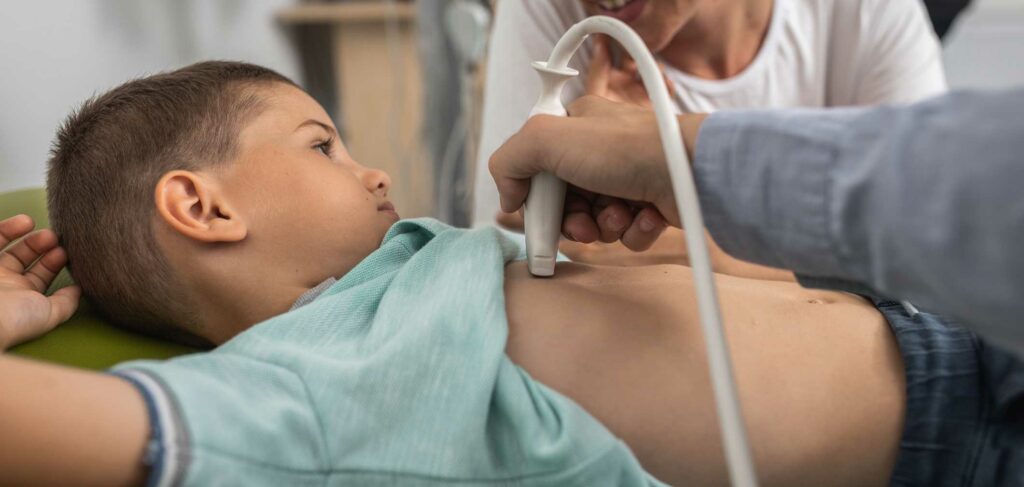Pediatric Exam Prep
Find out when you book
Pediatric Imaging Locations
Find out when you book.
Medically reviewed by Dr. Jacob Jaremko, M.D, Ph.D., FRCPC
What is a Pediatric Ultrasound Exam?
Pediatric ultrasound uses high-frequency sound waves, not ionizing radiation, to produce images of the inside of a child’s body. This form of diagnostic imaging helps evaluate many parts of the body, including the brain, hips, joints, abdomen, pelvis, and more.
Will My Child Feel Anything During the Ultrasound?
- The hypo-allergenic gel that is applied will feel like sunscreen. The gel is clear, water-soluble, and wipes off easily after the exam without leaving any residue.
- Your child may feel some discomfort while the transducer is pressed against their body – especially if the area of interest is tender.
Communication is Key
Please take the time to talk to your child before their appointment. The less stressed and anxious they are, the more cooperative they will be during their exam. Educate them about the procedure, hypo-allergenic gel, and pressure they will feel from the camera/transducer. Explain how the gel and camera help us capture high-quality images for our radiologists to review. The more cooperative your child is during the exam, the faster it will go.
Pediatric Ultrasound Exams at MIC
The most common pediatric ultrasound exams at MIC are:
- General ultrasound (abdomen, pelvis, neck/thyroid etc.)
- Head, hips, and spine ultrasound
- Heart ultrasound (Echocardiography)
- Musculoskeletal (MSK) ultrasound
How Long Does a Pediatric Ultrasound Take?
Pediatric ultrasound scans typically take between 5 and 30 minutes to complete. Your child’s age, interaction with our technologist, mobility, and area of interest can impact exam duration.
How Much Does a Pediatric Ultrasound Cost?
There is no cost for a pediatric ultrasound so long as you have a valid Alberta Health Care card. We also accept out-of-province health care cards, except for Quebec. Many other health insurance providers also cover the cost for this exam. If you are unsure, you should reach out to our team or your insurance provider for confirmation.
What Happens After My Child’s Pediatric Ultrasound?
One of our pediatric radiologists will review your child’s images, create a detailed report, and send the results to your referring doctor – usually within 24 hours.
How Do I Prepare My Child for Their Pediatric Ultrasound?
Generally speaking, children ten years old or younger do not have any preparation for their ultrasound exam.
Some special exams may require your child to fast or drink a certain amount of water before the exam to help our team capture images of the abdomen, pelvis, bladder, etc.
If your exam requires any preparation, our central booking team will review all the details with you when you schedule your appointment.
Pediatric Ultrasound Protocol
Pediatric ultrasound imaging is available at our Century Park and Terra Losa locations. The following exams have special age requirements. If your child does not fit the guidelines, their exam will be performed at the Stollery Children’s Hospital instead of our clinics.
Brain Ultrasound
- Age: Up to 9 months if anterior fontanelle is open
Heart Ultrasound (Echocardiography)
- Age: 16 years and older
Hip Ultrasound
- Age: 6 weeks to 6 months
(After 6 months, an x-ray may be required)
MSK Ultrasound
- Age: subject to radiologist approval
Lumps and Bumps Ultrasound
- Age: 17 years and under
Pyloric Stenosis Ultrasound
- Age: 3 months and under
(only available at the Stollery)
Scrotum Ultrasound
- Age: 17 years and under
(If related to cryptorchidism, your doctor will refer you to a Pediatric Urologist who will provide an initial consultation and order appropriate diagnostic imaging)
Spine Ultrasound
- Age: 6 months and younger
All Other Ultrasound Exams
- Age: no age restrictions and may be performed at other MIC clinics.

What Happens During a Pediatric Ultrasound?
- We may ask your child to change into a gown depending on the area of interest.
- Our sonographer will position your child on the exam table and apply a warm, water-based, hypoallergenic gel on your child’s skin.
- Once the gel is applied, we will place a transducer firmly against their body.
- The sonographer will move the probe back and forth until they capture enough high-quality images for our radiologist to examine.
